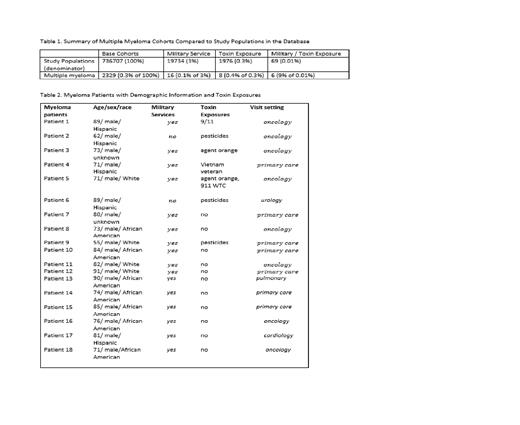Background: Multiple myeloma (MM) is a bone marrow-based, multifocal plasma cell neoplasm associated with an M-protein in serum and / or urine. Events mediating progression from the pre-malignant monoclonal gammopathy of undetermined significance (MGUS) to MM are not clearly understand. Numerous genetic events and environmental factors appear to trigger the progression of MM. Although there have been many studies on occupational and toxin exposures as risk factors to the development of non-Hodgkin's lymphoma, there are few studies that focus on military service and toxin exposures as potential risk factors to the development and progression of MM.
Aims: We present a descriptive analysis of MM occurrences in cohorts of patients with military background who had potential exposure to toxic agents. This is a cohort-based study that uses combination of structured clinical information from electronic health record (EHR) and natural language processing (NLP) of all clinical notes associated with patients.
Method: We first identified a cohort of 2329 patients diagnosed with MM. The inclusion in this cohort was ascertained by at least one occurrence of MM diagnosis including MM in remission, plasma cell leukemia in remission, or plasma cell leukemia in relapse in a cohort of 736,707 adult patients (age > 21) with an inpatient, outpatient, telehealth, or home visit between January 2016 to January 2023 in Montefiore Medical Center, Bronx, New York. All clinical notes associated with both cohorts were processed using a custom NLP query to identify cohorts of patients with military background (e.g., military service, Veteran, Vietnam war, army or navy or air force deployment). Another custom NLP query was used to identify cohort of patients with recorded history of toxic exposure (e.g., 9/11 world trade center, Agent orange, Mustard gas, Sarin gas, pesticides, herbicides, fungicides). All queries and NLP results were reviewed by the authors to ensure extraction of relevant patients, encounters, and notes.
Results: Our study investigates a cohort of approximately 2329 patients admitted to Montefiore Medical Center between 2016 and 2023 with diagnosis of MM. Table 1 summarizes the cohorts of MM patients in compared to the study population (denominator) in the database. Overall we identified sixteen patients with diagnosis of MM and some record of military background (Table 1). We identified eight patients with diagnosis of MM and history of toxin exposure. Among these two groups, six patients with diagnosis of MM were noted with history of military background and toxin exposure (Table 1). We then characterize the demographic information and clinical visits at diagnosis in the myeloma patients with military backgrounds / or toxin exposures (Table 2).
Conclusion: Our results demonstrate disproportionately high occurrence of multiple myeloma in patients with recorded history of military exposure to toxic agents when compared to other groups (9% vs 0.1% to 0.4%) and provides a rationale for further investigations.
Disclosures
No relevant conflicts of interest to declare.


This feature is available to Subscribers Only
Sign In or Create an Account Close Modal